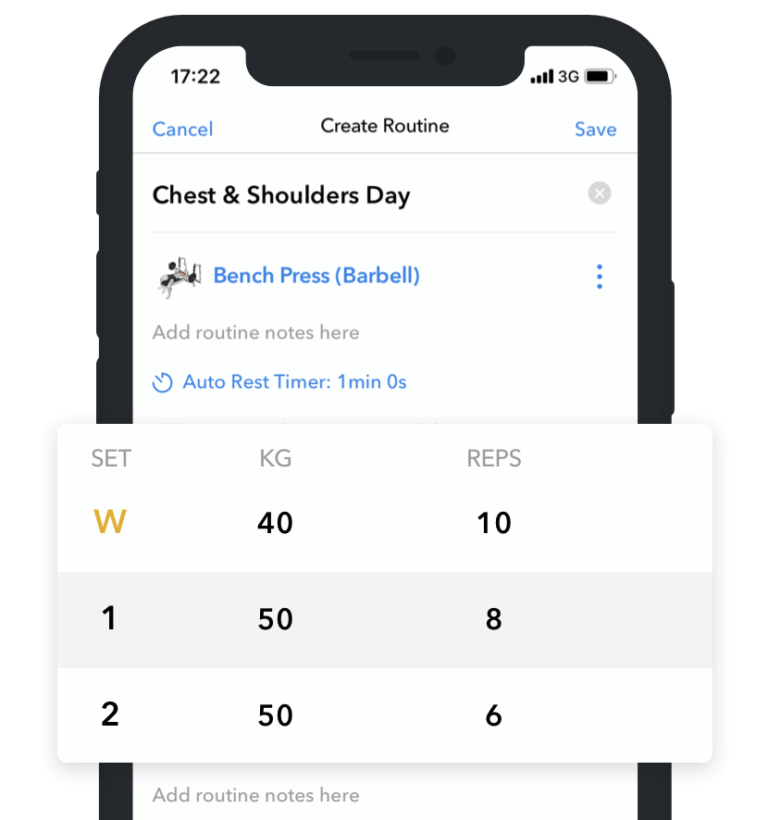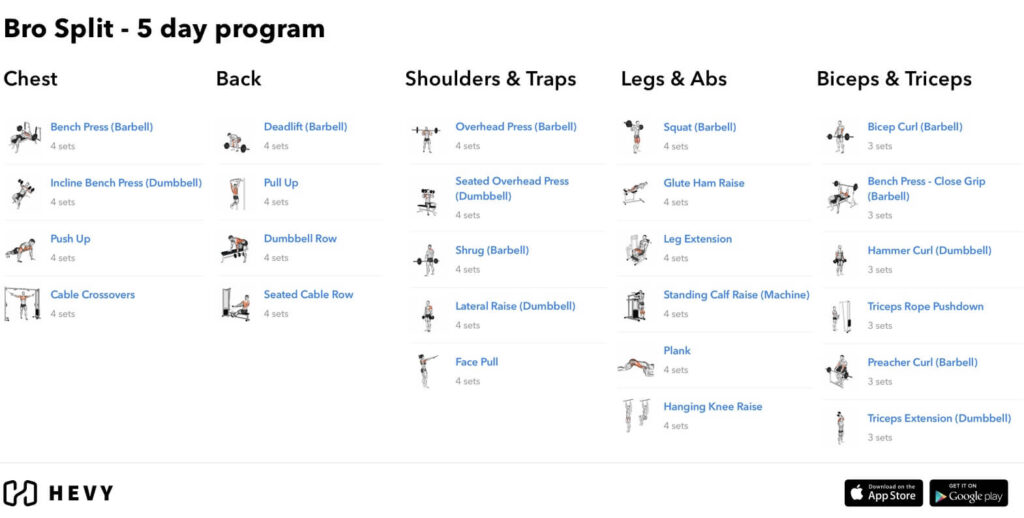What is the Bro Split Workout Program?
If you’ve ever considered lifting weights, then you’ve probably heard of the famous bro split. For decades, the bro split has been the golden standard for organizing our weekly training, and millions of people from all over the world praise the approach.
The bro split workout routine is nothing more than an approach to organizing your training, and there are many ways to go about that. For example:
Tuesday – Back and biceps
Wednesday – off
Thursday – Legs and abs
Friday – Shoulders
Saturday and Sunday – Rest
As you probably noticed, with the bro split, you devote each workout to one or two muscle groups. Typically, you train each muscle group once every seven days and do a total of three to six weekly workouts.

Hevy – Workout Tracker
Create your own workout splits with Hevy, and track your progress.









Hevy – Workout Tracker
Create your own workout splits with Hevy, and track your progress – for free.
One of the great things about the bro split is that you can vary the training frequency, depending on how often you can (or want to) train. You can also organize your weekly workouts in numerous ways. If you prefer to have shorter and more frequent workouts, the bro split can accommodate. If you don’t want to train chest on Monday, but on Thursday, you can do it. The scheduling flexibility is fantastic.
The bro split has been around for decades, and it’s been used by many bodybuilders. We don’t know exactly where it originated from, but, because of its simplicity, the bro split became incredibly popular among bodybuilders and recreational lifters alike.
Rather than thinking of elaborate ways to structure training and manage fatigue, people often go for the bro split because it’s simple to program and allows you to dedicate entire workouts to one or two muscle groups.
The Bro Split Workout Program
Now that we have a good understanding of what a bro split is, let’s take a look at how we can put together a program for ourselves.
This program will be a classic bro split with five weekly workouts. Here’s the schedule:
Tuesday – Back
Wednesday – Shoulders and Traps
Thursday – Legs and Abs
Friday – Biceps, Triceps, and Forearms
Saturday – Rest
Sunday – Rest
At first glance, how you schedule your workouts doesn’t seem to matter all that much, but your weekly schedule is vital. In other words, how you sequence your workouts throughout the week will make a huge difference.
For example, with the above schedule, we get to train different muscles and then give them ample time to recover. On Monday, you train your chest, shoulders (mostly the front delts), and triceps. Then, these muscles have a good 48 hours of recovery before you train them again on Wednesday.
On Tuesday, you train your back. Depending on what exercises you go with, that will also involve your legs to some degree. But, again, these muscles have two days to recover before they have to work again.


And then, we have strategic placement of arm training on Friday. This is a perfect time because your bicep and triceps will have had enough time to recover well before you train them directly. Now, let’s take a look at how you might structure each workout of your split:
Monday (Chest)
Flat barbell bench press – 4 sets of 6 to 8 reps
Incline dumbbell press – 4 sets of 8 to 12 reps
Plyometric push-ups – 4 sets of 10 to 20 reps
Low cable chest fly – 3 to 4 sets of 15 to 25 reps
Tuesday (Back)
Rack pull deadlifts – 4 sets of 5 to 8 reps
Pull-ups or chin-ups – 4 sets of 5 to 10 reps
Single-arm dumbbell row – 4 sets of 8 to 12 reps
Seated cable rows – 3 to 4 sets of 12 to 15 reps
Wednesday (Shoulders and Traps)
Overhead barbell push-press – 4 sets of 6 to 12 reps
Seated single-arm dumbbell overhead press – 4 sets of 8 to 12 reps
Standing barbell shrugs – 3 to 4 sets of 6 to 12 reps
Lateral cable shoulder raises – 3 to 4 sets of 12 to 20 reps
Cable face pulls – 3 to 4 sets of 15 to 25 reps
Thursday (Legs and Abs)
Barbell high-bar back squats – 4 sets of 6 to 10 reps
Glute-ham raises – 4 sets of 8 to 12 reps
Hack squats – 3 sets of 8 to 15 reps
Lying hamstring curls – 3 sets of 12 to 15 reps
Seated leg extensions – 2 to 3 sets of 12 to 20 reps
Machine calf raises – 2 to 4 sets of 10 to 20 reps
Hanging knee raises – 2 to 4 sets of 10 to 20 reps
Friday (Biceps, Triceps, and Forearms)
EZ-bar bicep curls – 3 sets of 6 to 10 reps
Close-grip bench press – 3 sets of 6 to 10 reps
Dumbbell hammer curl – 3 sets of 8 to 12 reps
Rope cable tricep extension – 3 sets of 10 to 15 reps
Preacher curl – 3 sets of 12 to 20 reps
Overhead tricep extensions – 3 sets of 12 to 20 reps
Plate pinches – 3 sets of 30 to 60-second holds (per hand)
As you can see, there is a healthy blend of different exercises for each major muscle group in the body. The goal is to train all muscles equally and avoid neglecting any of them. The training volume is also fairly average, but this is just an example. If you’re just starting with the bro split, consider doing fewer total sets at first to see how well you can recover. If everything goes well, slowly add sets here and there.









Hevy – Workout Tracker
Create your own workout splits with Hevy, and track your progress.









Hevy – Workout Tracker
Create your own workout splits with Hevy, and track your progress – for free.
Warming up is another vital thing to keep in mind. You don’t have to do anything crazy, but a combination of low-intensity cardio and dynamic movement can be beneficial for raising your core body temperature and preparing you for the workout.
And finally, there is the question of rest periods between sets. On average, you should rest anywhere from one to three minutes between sets, depending on how demanding the exercise is and how heavy the set is. As a rule of thumb, you should rest for as long as you need so that you can do all of your repetitions (1). As an example:
If you do six reps on the first set of bench press, ideally, you should be able to get at least five on the last. Mostly use your performance as an indicator of your rest, and you will do great.
Are Bro Splits An Effective Way to Build Muscle?
Over the years, the bro split has gained a fair amount of criticism because of its low frequency. The idea is, muscle protein synthesis tends to level off within 36 hours of training (2). So, by not training our muscles two to three times per week, we are effectively ‘missing out’ on potential muscle growth.
People who critique the bro split also suggest that folks who tend to do well with it are also taking performance-enhancing drugs. We won’t dive into the ethics of this, as this is far beyond the scope of this guide. What we will go over, however, is the overall effectiveness of bro splits, and why people unjustly look down upon them.


A few years ago, a study from Norway came about – the Norwegian project. In it, elite powerlifters were split into two groups:
- One group trained three times per week
- One group trained six times per week
What researchers in the study found was that the powerlifters who trained more frequently saw greater strength and muscle gains. The study was never published in a peer-reviewed journal to my knowledge, which is a bit strange.
Ever since then (and most likely because of that study), we saw a boom in studies that looked at training frequency and its effects. Interestingly enough, no other papers have been able to replicate this effect.
For example, in one study, researchers set out to test this theory on training frequency (3). In that trial, 28 young, healthy, and resistance-trained men were put in two groups: one group trained three times per week, the other group trained six. In both groups, training volume and intensity were equated.
After six weeks, both groups had experienced increases in bench, squat, and deadlift strength, as well as gains in lean body mass. But, there were no significant differences between the two groups. In conclusion, the researchers stated:
High-frequency (6× per week) resistance training does not seem to offer additional strength and hypertrophy benefits over lower frequency (3× per week) when volume and intensity are equated. Coaches and practitioners can therefore expect similar increases in strength and lean body mass with both 3 and 6 weekly sessions.
https://www.ncbi.nlm.nih.gov/pmc/articles/PMC6303131/
In other words, so long as we do enough work each week, our muscles will grow, and it doesn’t seem to matter how often we train them within a week. For example, if you need to do 16 sets for your chest each week, doing them within one workout or across two, three, or even four doesn’t seem to make much of a difference.
This idea is supported by most studies so far, including one by Gomes et al. that was published in 2019 (5). So, the hypothesis that we need to maintain muscle protein synthesis elevated doesn’t seem to have a solid foundation. Until research says otherwise, you can rest assured that the bro split will do a fantastic job at helping you build muscle.
The Bro Split Compared to Other Routines – How Does It Stack Up?
As a whole, the bro split looks solid. The question is, how does it stack up against the other popular alternatives like the?
Bro Split vs. Full-Body Split
If you’re unfamiliar with them, full-body splits have you train each muscle group in every workout. For example, you might do a schedule like:
Monday – Full Body
Tuesday – Off
Wednesday – Full Body
Thursday – Off
Friday – Full Body
Saturday & Sunday – Off
An individual workout might look like this:
Barbell back squats – 3 sets of 6 to 10 reps
Barbell bench press – 3 sets of 6 to 10 reps
Bent over barbell rows – 3 sets of 6 to 10 reps
Lateral dumbbell raises – 3 sets of 12 to 15 reps
Bicep curls – 3 sets of 12 to 20 reps
Tricep extensions – 3 sets of 12 to 20 reps
Calf raises – 3 sets of 12 to 20 reps
The question is, are full-body splits better than the bro split? You’d think research would have answered this question by now, right? Sadly, no research suggests either to be superior.
So long as we control for volume and intensity, the frequency of our training doesn’t seem to matter all that much. If anything, full-body training might feel a bit overwhelming for many people, as having dedicated days for individual muscle groups allows us to get in the zone and then get it out of the way for the remainder of the week.


Bro Split vs. Push Pull Legs
The push-pull-legs (PPL) is another popular way of organizing our weekly training, and many people wonder whether it works better than the classic body part split.
The idea of the PPL split is to break up your training for individual movement patterns. So, a ‘push’ workout will train your chest, shoulders, and triceps. An example workout might look like this:
Flat dumbbell bench press – 3 sets of 8 to 12 reps
Seated overhead dumbbell press – 3 sets of 8 to 12 reps
Lateral dumbbell raises – 3 sets of 12 to 15 reps
Cable chest fly – 3 sets of 12 to 15 reps
Overhead tricep extensions – 3 sets of 12 to 15 reps
Such a split might look like this:
Monday – Push
Tuesday – Off
Wednesday – Pull
Thursday – Off
Friday – Legs
Saturday & Sunday – Off
If your goal is to build strength and movement proficiency, then a high-frequency PPL split might work better. For example:
Monday – Push
Tuesday – Pull
Wednesday – Legs
Thursday – Push
Friday – Pull
Saturday – Legs
Sunday – Off
This is because research suggests that a higher frequency seems more beneficial for strength gain (6, 7).
But, again, so long as we do enough sets with adequate intensity, training frequency seems to be irrelevant for muscle gain.
Bro Split vs. Upper/Lower
Many people praise the upper/lower split because it allows us to train four days per week, and we get to train each muscle group twice a week. But, there are a few issues with it:
First, we have the issue of programming. While it may sound simple enough, designing a productive upper/lower split is difficult because you have to be extremely careful of your exercise selection. For example, you can do the deadlift as a back exercise on upper day, but that will also fatigue your legs, and your following lower session might suffer.
Second, there is the problem of volume allocation. You have two upper and two lower workouts – that’s fine. But, most people find programming challenging because their lower body workouts end up relatively short and of low volume. In contrast, their upper body workouts have to be incredibly long and challenging. This is because you have many more muscle groups in the upper body than you do in the lower half.
And finally, there is also the issue of priority on an upper lower split. The lower body is fine. But you have to make trade-offs for your upper body every week because you’re forced to prioritize one muscle group and train the others in a fatigued state. You only have two upper body workouts, and you’re forced to pick between starting with chest, back, or shoulders.
On a bro split, you have a day for every muscle group, and you can give them a lot more attention without having to deal with trade-offs. Other worthy mentions of popular splits are the 3 day split, 4 day split, and 5 day split.
What Are The Pros And Cons Of The Bro Split?


So far, we’ve established that the bro split can hold its own against the other famous routines. To help you even more, we’ve put together two handy lists of the pros and cons of bro splits. Let’s take a look:
Pros of the Bro Split
- It’s incredibly simple to program – all you have to do is decide how many days you’re going to train and split the different muscle groups.
- You get to train each muscle group in a fresher and more recovered state, thus doing more volume with better form.
- You have enough time to form a good mind-muscle connection with the muscle group you’re training that day, as there are more reps, sets, and exercises. This can also help you get in the zone more easily.
- Depending on your training frequency, your workouts might be shorter. Rather than cramming a lot of volume in fewer workouts, you get to spread that same volume across more weekly sessions.
- It could provide you with psychological relief. Rather than worrying about training large muscles like your back and quads several times per week, you know that you have two demanding workouts. You can go in, crush it, and then not worry about them for another six days.
- If you’re muscular and quite strong, your body will need more time to recover, and bro splits allow that to happen because you won’t have to train the same muscle for another six days.
- You might find it more enjoyable to dedicate a given workout to a specific muscle group, instead of splitting your attention between several.
As a whole, the bro split is a simple, effective, and engaging way of organizing your weekly training. But, as with most things, it also carries some drawbacks.
Cons of the Bro Split
- For you to follow a bro split as intended, you would have to dedicate at least four to five days each week. This might not be possible for some folks, and you might have to choose a split that is better suited for a low training frequency. Examples include the push-pull-legs and full-body.
- According to some experts and researchers, training our muscles only once per week might not be enough to maximize muscle growth, despite what research suggests. Still, if you prefer to follow a bro split – go ahead and don’t lose any sleep over it.
- A bro split might not be the best way to organize your weekly training if your goals are strength and skill acquisition. Research seems to suggest that training a given muscle group or movement pattern more frequently is better for strength gains (6, 7).
- Your performance will deteriorate more significantly as the workout progresses. By the time you do ten to sixteen sets for a given muscle group, it will be much weaker and less able to work productively. This might have some long-term muscle growth implications.
- As you first get started with bro split training, you will experience significant delayed-onset muscle soreness (DOMS). This is because your muscles will experience large amounts of physical stress in each workout, and it will take some time for your body to get used to that. You will most likely have to deal with some level of soreness each week, despite training regularly.
Progression With Bro Split Workouts
There are dozens upon dozens of fancy progression schemes out there, but where most of them fail is to account for one huge factor: We are humans, not machines.
Sure, you have set amounts you need to lift from week to week, and looking at the long-term progression seems exciting. “Whoa, so long as I stay consistent, I’ll be able to lift x amount for y number of reps by z date!”
The problem is, adaptations to resistance training happen non-linearly and often unpredictably. Apart from sleeping well, programming intelligently, training hard, and eating enough, there isn’t much we can do (8, 9, 10). How every one of us adapts to training will vary hugely and will depend on other factors that are outside of our control—for example, our genetics and daily stressors.
This is why studies show considerable differences in how people respond to the same training program (11).


There is also an argument to be made about progressive overload – do we force it by training harder, or does it occur as a result of our improvements? A question similar to the one about the chicken and the egg, and which comes first.
So, what does this mean for us? Well, with the research we have so far, it would be better to adopt an intuitive approach to progression. Rather than trying to follow a rigid progression scheme, adapt the loads based on how you feel. We all have our good and bad workouts, and it only makes sense that we account for that. Tracking your workouts, with Hevy for example, will allow you to see a clear progression of your workouts.









Hevy – Workout Tracker
Create your own workout splits with Hevy, and track your progress.









Hevy – Workout Tracker
Create your own workout splits with Hevy, and track your progress – for free.
Research also seems to suggest this idea and shows that folks who follow a more autoregulated approach tend to improve their strength better (12). But, to do that effectively, you should log your workouts and keep them as a reference when choosing your loads for each upcoming session. That way, you get to stay within an acceptable range of your typical loads, and you prevent yourself from slacking off.
How Long Should I Train to See Results?
This is a common question most people have, and it’s a logical one. After all, since we’re putting in the effort, we want to know how long it will take us to see results.
The problem is, this is quite the subjective question as we all have different goals. So, what some might consider ‘good progress,’ others might see as ‘barely any improvement.’
To make this as objective as possible, we’ll borrow Lyle McDonald’s model for potential muscle growth in a year. It looks like this:
- First year of training – up to 20 to 25 pounds of muscle gain (roughly two pounds per month)
- Second year of training – up to 10 to 20 pounds of muscle gain (one pound per month)
- Third year of training – 5 to 6 pounds of muscle gain (around half a pound per month)
- Fourth year (and beyond) – 2 to 3 pounds of muscle gain
Of course, this model is not without its faults, and it can’t accurately predict how much muscle every person will gain. But, it does a reasonably good job of illustrating what can be achieved through consistent training, proper nutrition, and good sleep.
Say that you’ve been training for a bit, and you’ve built some muscle. What would that mean for you? Well, it means that you probably haven’t exhausted your newbie gains yet, and you can likely gain more than a pound of muscle mass per month.
On the other hand, if you’re new to the gym but have always been active, strong, and have been playing various sports (or have had a physically-demanding job), then you might build a bit less muscle than what the above model suggests.
As a whole, you should take a look at how long you’ve been training consistently and intelligently and use Lyle’s model to guide you.
Conclusion
So, where do we stand on the bro split workout routine?
The protocol originated several decades ago and gained lots of popularity thanks to its straightforward approach to organizing our training. Ever since the early days, the bro split has gotten praise and critique from many – some deem it a fantastic way to train; others consider it a suboptimal approach.









Hevy – Workout Tracker
Create your own workout splits with Hevy, and track your progress.









Hevy – Workout Tracker
Create your own workout splits with Hevy, and track your progress – for free.
The most common critique against the use of bro split doesn’t seem to hold much water because training frequency doesn’t seem to be vital for growth (3). On the other hand, training volume is tightly correlated with hypertrophy, and, as we saw above, you can set up a high-volume program with the principles of bro splits (4).
As we saw in the guide, the bro split can be used to build muscle quite effectively, and it also offers some distinct advantages over other routines.
The bro split also holds its own against the other popular alternatives like push-pull-legs, upper/lower, and full-body. In fact, one could argue that the bro split is superior to the others precisely thanks to its simplicity and because, with minimal knowledge, you can set it up quite well.
Granted, like most things, bro splits also offer some drawbacks. But, with the right plan, consistency, effort, and good nutrition, you can achieve fantastic results with it. The best thing we reccommend for you to get the most out of your workouts is tracking your workouts with Hevy!
Frequently Asked Questions
Before we wrap up this guide, let’s take a look at some of the most commonly asked questions about the bro split:
Cardio is fantastic because it delivers numerous health benefits, improves our work capacity, and can serve as an excellent active recovery modality (13, 14). But, if you follow a high-frequency bro split, finding the right time for cardio can be difficult.
One option is to do your cardio after some of the workouts – for example, 20 to 30 minutes after three of your weekly workouts. Another (and possibly better) option is to do cardio on your recovery days. For example, if you train from Monday to Friday, do a couple of cardio sessions on Saturday and Sunday.

Bodyweight training gets a bad rap and many people today see it as an ineffective way of getting fit. But, according to research, so long as we push ourselves hard enough, we can build muscle and strength with bodyweight exercises quite well – at least in the short term (15, 16).
The only issue is, finding good bodyweight exercises for all muscle groups can be challenging, especially for body parts like the deltoids, biceps, and calves.
But, if your goal is to set up a bodyweight bro split, you can do it, and you can achieve impressive results, so long as you push yourself and improve over time.
The answer here mostly depends on how many days per week you plan to train and how much volume you have for each workout.
If you plan on training five days per week, then you should keep your workouts (not including the warm-up) to 45-60 minutes each. On the other hand, if you plan on training three or four times, like in a 3 day split, then you will have to do more work in each workout, and you will most likely have to train for more than an hour.
The most straightforward answer is this: Your workouts should be as long as they need so that you can do all of your exercises, sets, and reps.
Figuring out the right training frequency for yourself can be a bit challenging. If you were to ask most people this question, they would probably say something like, “Training six days per week is not a good idea.”
But, the truth is, so long as you allocate your weekly training volume appropriately, you can train six days per week without much issue. For example, you can follow a schedule such as the one below and finish most of your workouts within 40 to 50 minutes:
Monday – Chest
Tuesday – Back
Wednesday – Shoulders
Thursday – Legs
Friday – Biceps and triceps
Saturday – Abs and cardio
Sunday – Off
If you’re just getting started with training or are wondering whether you should recommend the bro split to a newbie, go ahead.
The bro split routine is fantastic for beginners because it’s easy to design, it allows beginners to form a better mind-muscle connection, and you have excellent scheduling flexibility. Plus, as a beginner, you don’t need much stress to cause growth and strength development, so you can make fantastic progress with it. However, if you’d like to start a bit slower, you can also workout 3 days or 4 days a week instead.




2 thoughts on “Bro Split – The Ultimate Workout Program Guide”
You can adjust this kind of split even further by adding rear delts to your back day since they’re commonly recruited in rowing motions. Such subtle tinkering with the split is the domain of the advanced bodybuilder who has a better grasp of the finer elements of training.
Hi Guillem,
I’ve been lifting for almost 20 years and have been looking for confirmation of doing the bro split. I cant understand why it’s so hated on…
With science, its looked at as “Not optimal ” due to low frequency and how we.dont need a full 7 days to recover.. I personally havent gotten any better gains from doing higher frequency programs. I find them taxing, tedious and mentally draining as theres no way to give full attention to chest and back in the same workout and progress, then do it again in 3-4 days!
I find bro splits more manageable, more fun, and feel more recovered . So should I just change up the exercises every 6 weeks or so and I can do this indefinitely?
Thanks so much for writing this article, I wish there was.more like it out there!
Nick